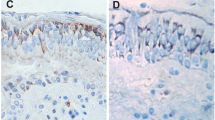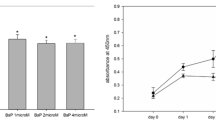Abstract
Diesel exhaust particles (DEPs) from diesel engines produce adverse alterations in cells of the airways by activating intracellular signaling pathways and apoptotic gene overexpression, and also by influencing metabolism and cytoskeleton changes. This study used human bronchial epithelium cells (BEAS-2B) in culture and evaluates their exposure to DEPs (15ug/mL for 1 and 2 h) in order to determine changes to cell rheology (viscoelasticity) and gene expression of the enzymes involved in oxidative stress, apoptosis, and cytotoxicity. BEAS-2B cells exposed to DEPs were found to have a significant loss in stiffness, membrane stability, and mitochondrial activity. The genes involved in apoptosis [B cell lymphoma 2 (BCL-2 and caspase-3)] presented inversely proportional expressions (p = 0.05, p = 0.01, respectively), low expression of the genes involved in antioxidant responses [SOD1 (superoxide dismutase 1); SOD2 (superoxide dismutase 2), and GPx (glutathione peroxidase) (p = 0.01)], along with an increase in cytochrome P450, family 1, subfamily A, polypeptide 1 (CYP1A1) (p = 0.01). These results suggest that alterations in cell rheology and cytotoxicity could be associated with oxidative stress and imbalance between pro- and anti-apoptotic genes.





Similar content being viewed by others

Abbreviations
- BEAS-2B:
-
Human bronchial epithelial cell line
- BCL-2:
-
B cell lymphoma 2
- DEP:
-
Diesel exhaust particles
- PAHs:
-
Polycyclic aromatic hydrocarbons
- LDH:
-
Lactate dehydrogenase
- MTT:
-
3-(4,5-dimethylthiazol-2-yl)-2,5-diphenyltetrazolium bromide
- OMTC:
-
Optical magnetic twisting cytometry
- *(f):
-
Complex apparent stiffness
- Pa/nm:
-
Pascal per nanometer
- η:
-
Hysteresivity
- G*:
-
The complex shear modulus
- g’:
-
The elastic modulus
- g”:
-
The loss modulus
- |G*|:
-
The complex modulus of G*
- G:
-
|G*| at 0.75 Hz
- SOD1:
-
Superoxide dismutase 1
- SOD2:
-
Superoxide dismutase 1
- GPx:
-
Glutathione peroxidase
- CYP1A1:
-
Cytochrome P450, family 1, subfamily A, polypeptide 1
References
Bales MP, Bruni AC et al (2014) Emissões veiculares no estado de São Paulo 2013. Companhia Ambiental do Estado de São Paulo, CETESB 2013. Available: http://www.cetesb.sp.gov.br/ar/emissao-veicular/48-relatorios-epublicacoes. Accessed Feb 02 2015
Berntsen P, Park CY, Rothen-Rutishauser B, Tsuda A, Sager TM, Molina RM, Zhou EH et al (2010) Biomechanical effects of environmental and engineered particles on human airway smooth muscle cells. J R Soc Interface 3:331–40
Block ML, Calderón-Garcidueñas L (2009) Air pollution: mechanisms of neuroinflammation and CNS disease. Trends neurosci 32(9):506–516
Bonvallot V, Baeza-Squiban A, Baulig A, Brulant S, Boland S, Marano F et al (2001) Organic compounds from diesel exhaust particles elicit a proinflammatory response in human airway epithelial cells and induce cytochrome p450 1A1 expression. Am J Respir Cell Mol Biol 25:515–21
Bursac P, Lenormand G, Fabry B, Oliver M, Weitz DA, Fredberg JJ (2005) Cytoskeletal remodelling and slow dynamics in the living cell. Nat Mater 4:557–61
Carvalho-Oliveira R, Saiki M, Pires-Neto RC, Lorenzi-Filho G, Macchione M, Saldiva PH (2005) Anti-oxidants reduce the acute adverse effects of residual oil fly ash on the frog palate mucociliary epithelium. Environ Res 98:349–54
Chen F, Vallyathan V, Castranova V, Shi X (2001) Cell apoptosis induced by carcinogenic metals. Mol Cell Biochem 22:183–8
Comporti M (1989) Three models of free radical-induced cell injury. Chem Biol Interact 72:1–56
Corsetto PA, Montorfano G, Zava S, Jovenitti IE, Cremona A, Rizzo AM et al (2011) Effects of N-3 Pufas on breast cancer cells through their incorporation in plasma membrane. Lipids Health Dis 73:1–16
Dalle-Donne I, Rossi R, Milzani A, Di Simplicio P, Colombo R (2001) The actin cytoskeleton response to oxidants: from small heat shock protein phosphorylation to changes in the redox state of actin itself. Free Radic Biol Med 31:1624–32
De Martinis BS, Okamoto RA, Kado NY, Gundel LA, Carvalho LRF (2002) Polycyclic aromatic hydrocarbons in a bioassay-fractionated extract of PM10 collected in São Paulo, Brazil. Atmos Environ 36:307–14
de Siqueira-Bueno HM, Martins RDSL, Pannuti C, dos Santos RN, Sowmy T, Junior FB, ... Saldiva PHN (2010) Metal embryotoxicity from urban particles in Sao Paulo city: An experimental study in chicken embryos. Ecotoxicol Environ Saf 73(6):1385–90
Delfino RJ, Staimer N, Tjoa T, Gillen DL, Polidori A, Sioutas C et al (2009) Air pollution exposures and circulating biomarkers of effect in a susceptible population: clues to potential causal component mixtures and mechanisms. Environ Health Perspect 117:1232–8
Dinardo CL, Venturini G, Zhou EH, Watanabe IS, Campos LC, Pereira AC et al (2013) Variation of mechanical properties and quantitative proteomics of VSMC along the arterial tree. Am J Physiol Heart Circ Physiol 306:505–16
Donaldson K, Brown DM, Mitchell C, Dineva M, Beswick PH, Gilmour P, MacNee W (1997) Free radical activity of PM10: iron-mediated generation of hydroxyl radicals. Environ Health Perspect 105(Suppl 5):1285
Doornaert B, Leblond V, Galiacy S, Gras G, Planus E, Laurent V et al (2003) Negative impact of DEP exposure on human airway epithelial cell adhesion, stiffness, and repair. Am J Physiol-Lung Cel Mol Physiol 284:119–32
Earnshaw WC, Martins LM, Kaufmann SH (1999) Mammalian caspases: structure, activation, substrates, and functions during apoptosis. Annu Rev Biochem 68:383–424
Fabry B, Maksym GN, Butler JP, Glogauer M, Navajas D, Fredberg JJ (2001) Scaling the microrheology of living cells. Phys Rev Lett 87 doi: 10.1103/PhysRevLett.87.148102
Ghio AJ, Cohen MD (2005) Disruption of iron homeostasis as a mechanism of biologic effect by ambient air pollution particles. Inhal Toxicol 17:709–16
Ghio AJ, Soukup JM, Case M, Dailey LA, Richards J, Berntsen J, ... Rappold A (2012) Exposure to wood smoke particles produces inflammation in healthy volunteers. Occup Environ Med 69(3):170–75
Gurgueira S, Sigaud S, Macchione M, Lawrence J, González-Flecha B (2007) H2O2-mediated proinflammatory and toxic responses to ambient air particles in primary alveolar type II cells. In: Bodine CG (ed) Air pollution research advances, 1st edn. Nova, New York, pp 1–17
Halliwell B, Gutteridge J (2007) Free radicals in biology and medicine. Oxford University Press, Nova York, pp 1–851
Jasinski R, Pereira LAA, Braga ALF (2011) Poluição atmosférica e internações hospitalares por doenças respiratórias em crianças e adolescentes em Cubatão, São Paulo, Brasil, entre 1997 e 2004. Cad de Saúde Pública 27:2242–52
Laks DM, Oliveira R, André P, Macchione M, Lemos M, Zin WA et al (2008) Composition of diesel particles influences acute pulmonary toxicity: an experimental study in mice. Inhal Toxicol 11:1037–42
Li N, Hao M, Phalen RF, Hinds WC, Nel AE (2003) Particulate air pollutants and asthma. A paradigm for the role of oxidative stress in PM-induced adverse health effects. Clin Immunol 109:250–265
Li N, Wangm M, Oberleym TD, Sempfm JM, Nel AE (2002) Comparison of the pro-oxidative and proinflammatory effects of organic diesel exhaust particle chemicals in bronchial epithelial cells and macrophages. J Immunol 169:4531–41
Livak KJ, Schmittgen TD (2001) Analysis of relative gene expression data using real-time quantitative PCR and the 2− ΔΔCT method. Methods 25:402–8
Miraglia SGEK, Saldiva PHN, Böhm GM (2005) An evaluation of air pollution health impacts and costs in São Paulo, Brazil. Environ Manag 35:667–76
Mossman T (1983) Rapid colorimetric assay for cellular growth andsurvival: application to proliferation and cytotoxicity assays. J Immunol Methods 65:55–63
Pan J, Chang Q, Wang X, Son Y, Zhang Z, Chen G, Shi X (2010) Reactive oxygen species-activated Akt/ASK1/p38 signaling pathway in nickel compound-induced apoptosis in BEAS 2B cells. Chem Res Toxicol 23(3):568–577
Park CY, Tambe D, Alencar AM, Trepat X, Zhou EH, Fredberg JJ et al (2010) Mapping the cytoskeletal prestress. Am J Physiol Cell Physiol 298:1245–52
Pope CA, Dockery DW (2006) Health effects of fine particulate air pollution: lines that connect. J Air Waste Manag Assoc 56:709–42
Pritchard RJ, Ghio AJ, Lehman JR, Winsett DW, Tepper JS, Costa D et al (1996) Oxidant generation and lung injury after particulate air pollutant exposure increase with the concentrations of associated metals. Inhal Toxicol 8:457–77
Pulido MD, Parrish AR (2003) Metal-induced apoptosis: mechanisms. Mutat Res Fundam Mol Mech Mutagen 533(1):227–41
Riss TL, Moravec RA (2004) Use of multiple assay endpoints to investigate the effects of incubation time, dose of toxin, and plating density in cell-based cytotoxicity assays. Assay Drug Dev Technol 2(1):51–62
Rodríguez-Cotto RI, Ortiz-Martínez MG, Rivera-Ramírez E, Mateus VL, Amaral BS, Jiménez-Vélez BD, Gioda A (2014) Particle pollution in Rio de Janeiro, Brazil: increase and decrease of pro-inflammatory cytokines IL-6 and IL-8 in human lung cells. Environ Pollut 194:112–120
Saldiva PH, Clarke RW, Coull BA, Stearns RC, Lawrence J, Godleski JJ et al (2002) Lung inflammation induced by concentrated ambient air particles is related to particle composition. Am J Respir Crit Care Med 165:1610–7
Salnikow K, Costa M (2000) Epigenetic mechanisms of nickel carcinogenesis. J Environ Pathol Toxicol Oncol 19:307–318
Seriani R, Junqueira MS, Toledo ACT, Saldiva PHN, Mauad T, Macchione M (2015a) Organic and inorganic fractions of diesel exhaust particles produce changes in mucin profile of mouse trachea explants. J Toxicol Environ Health A 78:215–25
Seriani R, Junqueira MS, Arruda ACT, Mauad T, Saldiva PH, Macchione M (2014) Diesel exhaust particulates affect cell signaling, mucin profiles, and apoptosis in trachea explants of Balb/C mice. Environ Toxicol. doi:10.1002/tox.22000 [Online 29 April 2014]
Seriani R, Junqueira MS, Saldiva PHN, Negri EM, Mauad T, Macchione M et al (2015b) Enriched inorganic compounds in diesel exhaust particles induce mitogen-activated protein kinase activation, cytoskeleton instability, and cytotoxicity in human bronchial epithelial cells. Exp Toxicol Pathol. doi:10.1016/j.etp.2015.02.004
Trepat X, Grabulosa M, Puig F, Maksym GN, Navajas D, Farré R (2004) Viscoelasticity of human alveolar epithelial cells subjected to stretch. Am J Physiol Lung Cell Mol Physiol 287:1025–34
Tsukue N, Okumura H, Ito T, Sugiyama G, Nakajima T (2010) Toxicological evaluation of diesel emissions on A549 cells. Toxicol in Vitro 24(2):363–369
Upadhyay D, Panduri V, Ghio A, Kamp DW (2003) Particulate matter induces alveolar epithelial cell DNA damage and apoptosis: role of free radicals and the mitochondria. Am J Respir Cell Mol Biol 29:180–87
Urbano AM, Ferreira LM, Alpoim MC (2012) Molecular and cellular mechanisms of hexavalent chromium-induced lung cancer: an updated perspective. Curr Drug Metab 13(3):284–305
Vasconcellos PC, Zacarias D, Pires MAF, Pool CS, Carvalho LRF (2003) Measurements of polycyclic aromatic hydrocarbons in airborne particles from the metropolitan area of São Paulo City, Brazil. Atmos Environ 37:3009–18
Wu Y, Yu T, Gilbertson TA, Zhou A, Xu H, Nguyen KT (2012) Biophysical assessment of single cell cytotoxicity: diesel exhaust particle-treated human aortic endothelial cells. PLoS One 7(5), e36885. doi:10.1371/journal.pone.0036885
Yoshizaki K, Brito JM, Toledo AC, Nakagawa NK, Piccin VS, Junqueira MS, Negri EM, Carvalho AL, Oliveira AP, Lima WT, Saldiva PH, Mauad T, Macchione M (2010) Subchronic effects of nasally instilled diesel exhaust particulates on the nasal and airway epithelia in mice. Inhal Toxicol 22:610–7
Zhou EH, Xu F, Quek ST, Lim CT (2012) A power-law rheology-based finite element model for single cell deformation. Biomech Model Mechanobiol 11:1075–84
Acknowledgments
This study was supported financially by the São Paulo Research Foundation (Fundação de Amparo à Pesquisa do Estado de São Paulo – FAPESP), Process No. 2011/50334-7. We would like to thank Cristina Grandal for editing the figures, and Dr. Carla Lima, and Marcio José Ferreira (Butantã Institute, São Paulo) and Thiago Franco Oliveira and Ana Paula Loureiro (University of São Paulo College of Pharmaceutical Sciences, Department of Clinical and Toxicological Analysis) for their help with cell cultures. Finally, we would like to thank Dr. Mário Luiz Ribeiro Monteiro (LIM33) and Roger Chammas (LIM24) for their critical analyses, suggestions, and technical support in the laboratory. Thais Mauad is funded by CNPq.
Author information
Authors and Affiliations
Corresponding author
Ethics declarations
Conflict of interest
The authors declare that they have no competing interests.
Additional information
Responsible editor: Philippe Garrigues
Rights and permissions
About this article
Cite this article
Seriani, R., de Souza, C.E.C., Krempel, P.G. et al. Human bronchial epithelial cells exposed in vitro to diesel exhaust particles exhibit alterations in cell rheology and cytotoxicity associated with decrease in antioxidant defenses and imbalance in pro- and anti-apoptotic gene expression. Environ Sci Pollut Res 23, 9862–9870 (2016). https://doi.org/10.1007/s11356-016-6228-x
Received:
Accepted:
Published:
Issue Date:
DOI: https://doi.org/10.1007/s11356-016-6228-x



